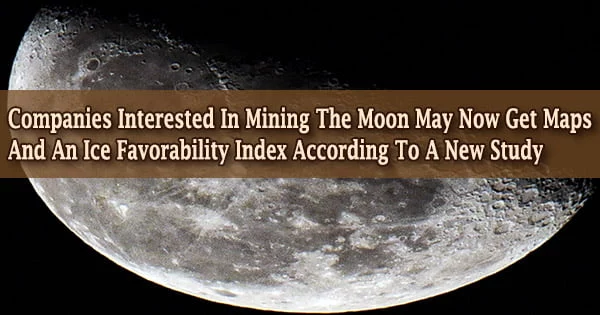During the California Gold Rush, the 49ers who panned for gold had no idea where they could strike it rich. They only had a word of mouth and little else.
Prospectors trying to mine the moon should have a better chance of striking gold, which means large amounts of water ice that can be transformed into commodities like fuel for space voyages, according to researchers from the University of Central Florida.
An Ice Favorability Index was devised by a team led by planetary scientist Kevin Cannon. The geological model describes how ice forms at the moon’s poles and maps the surface, which contains craters that could potentially hold ice deposits.
The model, which was published in the peer-reviewed journal Icarus, takes into consideration what asteroid strikes on the moon’s surface would do to ice deposits discovered meters beneath the surface.
“Despite being our closest neighbor, we still don’t know a lot about water on the moon, especially how much there is beneath the surface,” Cannon says. “It’s important for us to consider the geologic processes that have gone on to better understand where we may find ice deposits and how to best get to them with the least amount of risk.”
Mining corporations on Earth, which do comprehensive geological studies and acquire core samples before investing in expensive extraction sites, inspired the team. Mining corporations do field mapping, extract core samples from probable sites, and try to figure out the geological reasons for the creation of the mineral they’re seeking for in a given location. In other words, they build a model of what a mining zone would look like before investing money to drill.
Despite being our closest neighbor, we still don’t know a lot about water on the moon, especially how much there is beneath the surface. It’s important for us to consider the geologic processes that have gone on to better understand where we may find ice deposits and how to best get to them with the least amount of risk.
Kevin Cannon
The scientists at UCF took a similar strategy, analyzing data gathered over time about the moon and running simulations in the lab. They had data from satellite surveys and the first journey to the moon, even though they couldn’t obtain core samples.
Why Mine the Moon
Spacecraft must be able to launch and continue on long journeys in order for humans to explore the solar system and beyond. Fuel is one of the issues.
Because there are no gas stations in space, spacecraft must carry extra fuel for extended voyages, and this fuel is heavy. Mining the moon could result in the production of fuel, lowering flight costs by eliminating the need to transport extra fuel.
According to various previously published experiments, water ice may be cleaned and processed to provide both hydrogen and oxygen for propellants. This process could be finished on the moon in the future, effectively creating a gas station for spaceships. Asteroids could also provide similar fuel resources.
Some believe that a network of these “gas stations” would mark the beginning of space industrialization.
A number of private firms are investigating lunar mining techniques. According to the report, both Luxembourg and the United States have passed legislation granting residents and corporations ownership rights to materials mined in space, including the moon.
“The idea of mining the moon and asteroids isn’t science fiction anymore,” says UCF physics Professor and co-author Dan Britt. “There are teams around the world looking to find ways to make this happen and our work will help get us closer to making the idea a reality.”
The study was made possible through a collaboration between NASA’s Solar System Exploration Research Virtual Institute and the University of Central Florida’s Center for Lunar and Asteroid Surface Science (CLASS).





